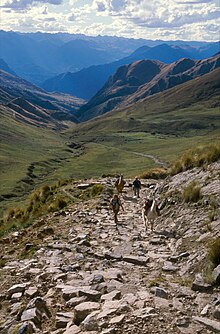Inca road system
The Inca road system was laid out by the Inca based on the work of pre-Inca cultures, mainly the Huari and Chimú cultures . It was the most advanced and extensive transportation system in pre-Columbian South America. Together with many connecting roads, main and secondary roads, it resulted in a road network of more than 30,000 kilometers that ran through the entire Inca Empire. It connected the cities of Quito ( Ecuador ) in the north and Santiago ( Chile ) or Mendoza ( Argentina ) in the south and allowed the Inca chief political and economic control of his empire. Urgent messages or instructions could be delivered in a short time by express messengers ( Chaski ). Likewise, taxes, trade goods and supplies could be distributed to the furthest corners of the empire by porters and lamas . A small group of Spanish conquerors also came to the powerful empire in this way.
Along the entire road network there were storage facilities, overnight accommodations, lama enclosures , housing developments and military posts in various sizes and designs, all at uniform distances from one another. Much of the road system was above 3,500 meters and connected inhabited regions, administrative centers, agricultural areas and mining areas, as well as ceremonial centers . The stone-paved street, up to twenty meters wide, led over steps to heights of over 4,500 meters and with footbridges and suspension bridges over water and raging rivers. The quality of the building can already be assessed by the fact that it is still in use in many places today, more than 400 years after its creation.
The most important part of the system was the Andes main road in north-south direction: Qhapaq Ñan . It stretched for more than 6000 kilometers and is comparable to the Silk Road in Asia. A second north-south connection ran along the coast and is now on the same track as the Panamericana .
Inca trails
The well-known Peruvian Inca Trail is the part of the Inca Road that connected the Sacred Valley of Cusco and Machu Picchu and thus only a small part of this network.
The Ecuadorian Inca Trail that linked Achupallas and Ingapirca is another part.
conservation
This precious archaeological legacy still exists today, although it is on the verge of disappearing.
The UNESCO , IUCN and Conservation International have the particular urgency of protecting, exposed along with the six countries through which the Great Inca road leads.
There are numerous archaeological sites along the King's Road of the Andes , some of which are World Heritage Sites . These include Ingapirca in Ecuador, Cusco and the Sacred Valley in Peru, Tiwanaku in Bolivia and Quilmes in Argentina, as well as smaller sites such as Huanuco Pampa in Peru, which are in need of protection.
The road connects 15 of South America's 100 ecosystems, of which the Peruvian Yungas , Marañon Dry Forest , Chilean Mattoral, and Chilean Winter Rainforest are at risk. Furthermore, it leads through some of the last existing retreats of the Andean spectacled bear , the Andean condor and the vicuña . The road also crosses the Andes Cordillera, a watershed between the valleys and the coast.
The Qhapaq Ñan passes through a number of indigenous areas with cultures anchored in the past. The Inka Naani project in Peru led to a revival of traditions and oral tradition.
The common goal of UNESCO and the countries through which the Qhapaq Ñan passes is the preparation of a candidacy for the inclusion of the Qhapaq Ñan on the list of world cultural heritage.
For example, a specific conservation project was initiated in 2016 in the Tarija Department (Bolivia). The section in the municipality of Yunchará and the descents to the central valley of Tarija are to be made more accessible for tourist purposes and connected to the overall network.
literature
- Robert Lessmann: Peru - Andes and Inca ways . In: Ders .: The little people who carry great burdens . Vienna 2008. ISBN 978-3-85476-263-8 .
- Victor von Hagen, Capac ñan, Fateful Road of the Incas, Rowohlt (1982)

